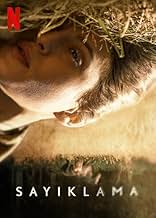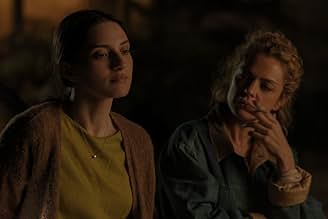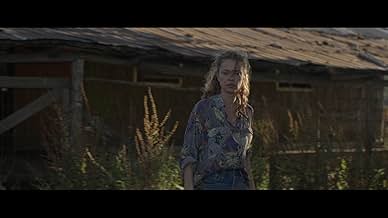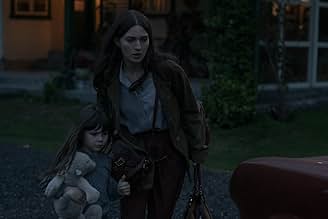CALIFICACIÓN DE IMDb
5.4/10
2.6 k
TU CALIFICACIÓN
Contará la inquietante historia de almas rotas, toxinas, catástrofes ambientales y espirituales que se avecinan y los lazos que unen a un padre con un hijo.Contará la inquietante historia de almas rotas, toxinas, catástrofes ambientales y espirituales que se avecinan y los lazos que unen a un padre con un hijo.Contará la inquietante historia de almas rotas, toxinas, catástrofes ambientales y espirituales que se avecinan y los lazos que unen a un padre con un hijo.
- Dirección
- Guionistas
- Elenco
- Premios
- 1 nominación en total
Opiniones destacadas
For this entire movie, you watch people alternate between losing their minds over nothing, under-reacting to major issues, and rambling about crack-pot theories. But you keep watching because the story is told so well that you find yourself sucked into it.
Then at one instant, you'll realize that the entire thing is essentially just an anti-science rant that's based on a serious lack of understanding of numerous topics. And that's not even a spoiler. Because the actual topic is so moronic and far-fetched that you would never guess it with 1000 tries.
They should have just gone with "It's aliens.". It's just as dumb, but at least it makes sense.
Then at one instant, you'll realize that the entire thing is essentially just an anti-science rant that's based on a serious lack of understanding of numerous topics. And that's not even a spoiler. Because the actual topic is so moronic and far-fetched that you would never guess it with 1000 tries.
They should have just gone with "It's aliens.". It's just as dumb, but at least it makes sense.
You can tell the negative reviewers were expecting a "horror movie" with "scares." Fever Dream is not a spooky ghost movie. It's a psychological drama with an element of magical realism. The story is very coherent and very clearly explained; it would only be confusing to someone who thinks "supernatural" elements must fit into a well established trope, like a curse or a haunting. The original novella had a more surreal, more disturbing sense of desperation, confusion and sadness that would be difficult to translate to film, and they didn't fully do it justice, but it's still competently made. Bottom line is that the book was better but the bad reviews are still mostly just clueless.
Summary:
The director Claudia Llosa carries out a complex and disturbing story, quite faithful to the novel by Samanta Schweblin (both are co-writers of the film), a psychological thriller with edges of terror where the threats and the danger that tighten the rope of the "distance of rescue " between a mother and her little daughter could be located in fantastic elements, in the most real of worlds, or in both.
Review
Amanda (María Valverde) arrives at a country house to spend a vacation with her little daughter Nina. There she establishes a relationship with a neighbor, Carola (Dolores Fonzi), mother of a disturbing boy named David. From certain revelations from Carola, Amanda will perceive a growing sense of danger.
Of course, Fever Dream widely transcends this synopsis. It was a challenge to transfer to the cinema the extraordinary homonymous nouvelle of the Argentine Samanta Schweblin, given its complex narrative structure, which the film by Claudia Llosa (co-writer with the novelist) maintains and which makes the film retain a certain literary imprint.
This complexity has to do with several factors, basically with the point of view. The story is narrated and driven by an off-screen dialogue between Amanda and David, in which he precisely guides the former (and the viewer) on a journey through the extensive flash back that constitutes most of the film. It is not known where (either exactly when) this dialogue takes place, but it occurs at a critical moment for Amanda, in which David's voice forces her to search for the keys to understand what happened, to understand how it got there. It should be noted that there was no way to avoid that literary dialogue in off of a double narrator since it is essential for the structure and the sense of the story. The timelines, which come and go, and which at times open like a set of Chinese boxes, are complex but quite clear.
In this story Amanda mentions what she calls "rescue distance" (itle of the film and the novel in Spanish), which she understands as the maximum distance that can exist between a mother and her child so that she can keep him or her safe and which is perceived as an invisible thread that unites them and that reaches its maximum tension when that distance is reached and that can be broken if exceeded. The concept of distance as a limit that operates in a bond and that is a factor of anguish in the film, takes on a disturbing premonitory quality (the novel predates the covid pandemic) since it is inevitable to relate it to that of social distance and with other realities of a threatening environment.
Carola tells Amanda (who is waiting for her husband to arrive to join her vacation) what happened to her son, a disturbing story that, added to the voice-over story, will mark the climate of the entire history. In this way, Llosa carries out a complex and disturbing story about these two mothers and their children, a kind of psychological thriller with edges of terror where the threats and the danger that tighten the rope of the rescue distance between mother and daughter could be located in fantastic elements, in the truest of worlds, or both.
Valverde, Fonzi and the children are very good in their roles and the complex fragmentary narrative structure of the film is excellently assembled. The film exploits very well the beautiful exteriors where it takes place and which are also, in some way, essential protagonists of the story.
I must clarify that my vision of the film was somewhat "contaminated" because I read the book before. I can point out that the adaptation is quite faithful to the novel, although in it the sensation of terror is more suffocating because the story is more urgent. But also, having read it, the disturbing is perceived from before. That is why it is not a bad idea to see this movie again knowing where it is going.
The director Claudia Llosa carries out a complex and disturbing story, quite faithful to the novel by Samanta Schweblin (both are co-writers of the film), a psychological thriller with edges of terror where the threats and the danger that tighten the rope of the "distance of rescue " between a mother and her little daughter could be located in fantastic elements, in the most real of worlds, or in both.
Review
Amanda (María Valverde) arrives at a country house to spend a vacation with her little daughter Nina. There she establishes a relationship with a neighbor, Carola (Dolores Fonzi), mother of a disturbing boy named David. From certain revelations from Carola, Amanda will perceive a growing sense of danger.
Of course, Fever Dream widely transcends this synopsis. It was a challenge to transfer to the cinema the extraordinary homonymous nouvelle of the Argentine Samanta Schweblin, given its complex narrative structure, which the film by Claudia Llosa (co-writer with the novelist) maintains and which makes the film retain a certain literary imprint.
This complexity has to do with several factors, basically with the point of view. The story is narrated and driven by an off-screen dialogue between Amanda and David, in which he precisely guides the former (and the viewer) on a journey through the extensive flash back that constitutes most of the film. It is not known where (either exactly when) this dialogue takes place, but it occurs at a critical moment for Amanda, in which David's voice forces her to search for the keys to understand what happened, to understand how it got there. It should be noted that there was no way to avoid that literary dialogue in off of a double narrator since it is essential for the structure and the sense of the story. The timelines, which come and go, and which at times open like a set of Chinese boxes, are complex but quite clear.
In this story Amanda mentions what she calls "rescue distance" (itle of the film and the novel in Spanish), which she understands as the maximum distance that can exist between a mother and her child so that she can keep him or her safe and which is perceived as an invisible thread that unites them and that reaches its maximum tension when that distance is reached and that can be broken if exceeded. The concept of distance as a limit that operates in a bond and that is a factor of anguish in the film, takes on a disturbing premonitory quality (the novel predates the covid pandemic) since it is inevitable to relate it to that of social distance and with other realities of a threatening environment.
Carola tells Amanda (who is waiting for her husband to arrive to join her vacation) what happened to her son, a disturbing story that, added to the voice-over story, will mark the climate of the entire history. In this way, Llosa carries out a complex and disturbing story about these two mothers and their children, a kind of psychological thriller with edges of terror where the threats and the danger that tighten the rope of the rescue distance between mother and daughter could be located in fantastic elements, in the truest of worlds, or both.
Valverde, Fonzi and the children are very good in their roles and the complex fragmentary narrative structure of the film is excellently assembled. The film exploits very well the beautiful exteriors where it takes place and which are also, in some way, essential protagonists of the story.
I must clarify that my vision of the film was somewhat "contaminated" because I read the book before. I can point out that the adaptation is quite faithful to the novel, although in it the sensation of terror is more suffocating because the story is more urgent. But also, having read it, the disturbing is perceived from before. That is why it is not a bad idea to see this movie again knowing where it is going.
I've never watched a movie with a rate under 6, but I'm making an exception for this. I like the storyline which makes me curious what happens next, even though makes me confused at the same time, but I don't really like the sad ending.
Fever dreams ... or crazy reality? And caused by what exactly? I am still rather confused by many things depicted by the movie. That may be enticing or it may be annoying to you. Depending on how much time and will you have to fully take this in and digest it ... well that will determine how much you probably will like it.
You can't just watch this while doing something else. Like having your phone and doing stuff on it while "watching" the movie. I have done this with lesser titles, so I am not judging. Some movies are more than predictable and do not really glue you to the screen. This is different ...
You can't just watch this while doing something else. Like having your phone and doing stuff on it while "watching" the movie. I have done this with lesser titles, so I am not judging. Some movies are more than predictable and do not really glue you to the screen. This is different ...
¿Sabías que…?
- TriviaThis is the first Netflix original film from Peru.
Selecciones populares
Inicia sesión para calificar y agrega a la lista de videos para obtener recomendaciones personalizadas
- How long is Fever Dream?Con tecnología de Alexa
Detalles
- Tiempo de ejecución
- 1h 33min(93 min)
- Color
- Mezcla de sonido
- Relación de aspecto
- 2.39 : 1
Contribuir a esta página
Sugiere una edición o agrega el contenido que falta


























